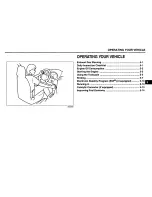
Make sure that all replacement tires are of the same size, type,
load-carrying capacity and tread design (e.g., ‘‘All Terrain’’, etc.),
as originally offered by Ford.
Failure to follow these precautions may adversely affect the
handling of the vehicle and make it easier to lose control and roll
over.
Tires that are larger or smaller than your vehicle’s original tires may also
affect the accuracy of your speedometer.
USING SNOW TIRES AND TRACTION DEVICES
Snow tires must be the same size and grade as the tires you
currently have on your vehicle.
The tires on your vehicle have all-weather treads to provide traction in
rain and snow. However, in some climates, using snow tires and traction
devices may be necessary. Ford offers tire cables as a Ford approved
accessory and recommends use of these or their equivalents. See your
dealer or qualified service technician for more information on tire cables
for your vehicle.
Follow these guidelines when using snow tires and traction devices:
•
Do not use tire chains on aluminum wheels. Chains may chip the
wheels.
•
Install cables securely, verifying that the cables do not touch any
wiring, brake lines or fuel lines.
•
Drive cautiously. If you hear the cables rub or bang against the
vehicle, stop and retighten them. If this does not work, remove the
cables to prevent vehicle damage.
•
Avoid overloading your vehicle.
•
Remove the tire cables when they are no longer needed.
•
Do not use cables on dry roads.
•
The suspension insulation and bumpers will help prevent vehicle
damage. Do not remove these components from the vehicle when
using snow tires and traction devices.
•
Do not exceed 48 km/h (30 mph) with tire cables on your vehicle.
Maintenance and care
181
















































